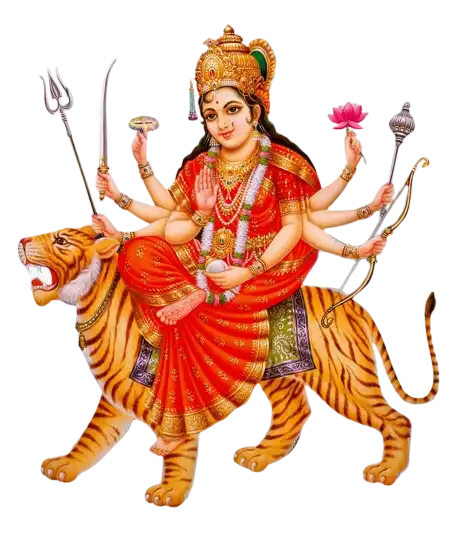1. The Legend of Maa Durga
The legend of Maa Durga's emergence is a captivating tale of divine intervention to restore cosmic balance. Born from the combined energies of Brahma, Vishnu, and Shiva, the principal deities of the Hindu trinity, Durga was created to combat the buffalo demon Mahishasura, who had become invincible to any man or god. Durga, a manifestation of Shakti (divine feminine energy), embodies the collective strength of all gods and is depicted as a radiant warrior goddess riding a lion or tiger, wielding weapons in her multiple hands.
2. Symbolism and Iconography
Durga's iconography is rich with symbolism. Each of her weapons, gifted by various gods, represents a different aspect of divine energy or virtue. For instance, the trident (or trishul) symbolizes the destruction of ignorance and evil; the conch (shankh) represents the primordial sound of creation; and the bow and arrows signify energy. Her mount, the lion or tiger, epitomizes power and determination. These symbols collectively convey Durga's role as a protector and warrior against the forces of evil and injustice.
3. Durga Puja: The Celebration of Divine Femininity
Durga Puja, one of the most significant festivals in Hinduism, especially in Eastern India, celebrates the victory of Maa Durga over Mahishasura. This festival epitomizes the victory of good over evil and is a time of joyous celebration, reflection, and community gathering. Elaborate rituals, cultural performances, and artistic expressions through the creation of magnificent clay idols mark this vibrant festival. Durga Puja is not just a religious event but a cultural phenomenon that brings together diverse communities to celebrate the goddess's blessings.
5. FAQs
Maa Durga is worshipped as the ultimate embodiment of power, protection, and virtue. Her devotees seek her blessings for strength, prosperity, and guidance in overcoming obstacles and evils in their lives.
Yes, Maa Durga can be worshipped at home through rituals, chanting mantras, and setting up a small altar or space dedicated to the goddess. Offering flowers, fruits, sweets, and meditating on her form are common practices.
The lion or tiger symbolizes power, will, and determination. It represents Maa Durga's mastery over all these qualities, as well as her role as the protector of righteousness and dharma.
Durga Puja is celebrated with great fervor through the creation of elaborate idols of the goddess, public celebrations, cultural programs, and community feasts. It is a time for prayer, reflection, and rejoicing in the goddess's blessings.
6. Online Resources
-
Durga Puja Virtual Tours: Many websites and cultural organizations offer virtual tours of Durga Puja pandals and celebrations, allowing people from around the world to experience the festival.
-
Online Puja Services: Various platforms offer online puja services where individuals can participate in rituals and offerings to Maa Durga remotely.
-
Spiritual Texts and Scriptures: Access digital copies of texts like the Devi Mahatmya, which details the exploits of Maa Durga, and provides insights into her significance and worship.
-
Art and Music: Explore the rich tradition of art and music inspired by Maa Durga through online galleries and streaming platforms, which feature devotional songs, classical music, and dance performances.
7. Conclusion
Maa Durga stands as a beacon of strength, courage, and divine protection. Her legends and worship practices underscore the importance of righteousness, the power of unity, and the celebration of feminine divinity. As a goddess who transcends the boundaries of time and culture, Maa Durga's teachings and blessings continue to inspire and uplift individuals, guiding them towards the path of virtue and righteousness in their lives.
8. Must Watch

